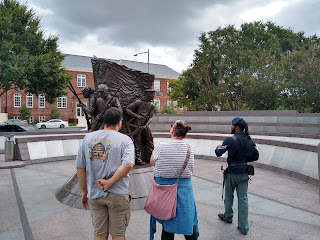 |
| Halloween 2020: No masks in 2023, but too cold for just a sweatshirt |
It's a very cold day for Halloween, likely to hold traffic down. We'll have no snow such as our Minnesota and Chicago correspondents report, but it's expected to be 35 at 6 this evening, with the wind making it feel even colder. Ten years ago I reported 145 visitors, but last year on a pleasant evening we had a mere 46, and this year we are less optimistic. Between the weather, the relatively low "door density" in my streetcar suburban neighborhood, and declining participation on my side of the street, there's not much reason to draw a crowd.
Halloween at its best is the great neighborhood holiday. Christmas gets more decoration, Fourth of July makes more noise, but Trick-or-Treating gets children, and often their parents, out to meet their neighbors. (Or someone's neighbors... we seem to get a fair amount of drive-to Trick-or-Treating every year.) Like Addison del Maestro, we have neighbors, around the corner on Crescent Street, who go way over-the-top with their decoration, including everyone who passes by in their celebration. "I can imagine being a kid," he writes, "and waiting with excitement to see what the next holiday is going to look like. It makes me feel like a kid."
Emma Durand-Wood writes on Strong Towns that maintaining Halloween traditions through the pandemic helped her husband realize it "wasn't really about the candy":
Now he could see that opening one’s doors to any and all strangers who showed up was really the ultimate act of neighborliness and hospitality. What’s the first thing you do when someone comes to your home? You welcome them warmly and offer them something to eat or drink. Around the world, hospitality looks like some variation of that. So, Halloween is like a neighborhood-wide expression of low-stakes, high-yield hospitality.
Halloween done right requires walkable neighborhoods. You can't do Halloween on a dark lonely street, or on a stroad, or in a large lot subdivision, or in a high-rise. Ironically, however, the biggest challenge to traditional Trick-or-Treating is from "trunk-or-treat" gatherings put on by shopping plazas, churches, and other organizations. I would say you can't do Halloween walking from space to space in a parking lot, but apparently you can. It's just a poor substitute for calling on your neighbors.
 |
So where does that leave children and their families who live in places that are genuinely unsafe to Trick-or-Treat? It leaves them in places that are unsatisfactory, not just on October 31, but every day of the year. And maybe this year trunk-or-treat is the best we can do?
But at the same time, for their sake, and for the sake of strong community bonds that we're failing in so many places to develop, we should all put our shoulders to the job of fixing what makes their places unsafe: providing escorts and patrols; slowing the cars, if not closing streets altogether; building and maintaining sidewalks; improving lighting; building housing that has front porches and windows for "eyes on the street."
Halloween done right is a celebration of neighbors and neighborliness, and faith in humanity. It's a tacit recognition of design that facilitates mixing with others. It's a rejection of moral panics about poisoned candy or the people who want to frighten you with dangers all around us.
P.S.--We were pessimistic about the turnout, as it happened! We had 62 before we ran out and turned off the light, so we could have had more. It was our biggest crowd since 2018 (97).
SEE ALSO:
Ryan Allen, "Trick-or-Treat is Worth Saving," Strong Towns, 30 October 2023
Jessica Grose, "Stop Micromanaging Halloween--Let Your Kids Be Free," New York Times, 25 October 2023
Brent Toderian, "Why the 'Trick-or-Treat Test' Still Matters," CityLab, 30 October 2023














